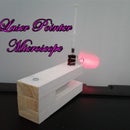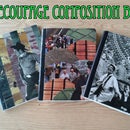Introduction: Making Faux PVC Bamboo
I love it when a project comes together! I got the idea for this project about four hours ago and now I'm posting it.
It all started with zaphodd42's Make PVC Look Like Wood instructable. I use PVC in a lot of projects and I'd never thought of using this approach. I was reading the comments and someone asked about simulating bamboo in PVC. My friend and partner in the local maker scene Instructomaker suggested using a heat gun to soften the PVC and compressing the two sides to make it flare out. Hmmm....
I ran out to the garage, grabbed some scraps of PVC and a heat gun and started tinkering. Here's what I came up with-
Step 1: Shaping the PVC
I started by using an old kitchen knife to scratch some long grooves into the PVC to simulate grain. I heated and shaped each node one at a time. I wrapped a loop of baling wire around each node and gently heated it with a heat gun until it was soft. I rolled the piece back and forth as I heated it to insure it softened evenly. I then forced the pipe together causing the softened plastic to flare out while the wire loop prevented the center of the bulge from expanding. This gave each node the classic bamboo look. The important thing is to be patient, work in a well ventilated area and never over-heat or burn PVC. This can be very dangerous.
When the nodes where shaped and cooled down I gave the whole piece a good sanding to smooth out the rough spots and prepare it for painting.
Step 2: Painting the Faux Bamboo
This was a very fun project because it combined three of my favorite things- PVC, bamboo and spray paint! Spray paint is idea for creating organic textures and color gradations because it's transparent. You can build up really deep, rich colors easily.
You can follow the pics above for the step-by-step process, but basically I painted the whole thing brown and then wiped it down with a rag leaving dark accents. Then I built up thin layers of color, accenting the nodes. I used spatter to simulate mold growth and rubbed brown paint into the groove of the nodes to darken them. I let it rest for a few minutes a couple times, but mostly the paint was put on in thin layers, wet-on-wet. When it was done I gave it a good wipe down with an alcohol soaked rag to smooth the surface and remove the last bit of uncured paint. This kinda 'marries' everything and eliminates any sharpness, making everything look organic.
Step 3: What's Next?
OK, so that was quick and easy. What next?
I've made flutes out of PVC and bamboo. Both materials have their pros and cons. Bamboo looks really cool but it's fragile, it likes to split as it ages and it's hard to get the inner diameter uniform enough to tune it properly. PVC flutes are easy to make and they're virtually indestructible, but they look a little drab. A PVC flute with the look of a bamboo flute would be really cool.
So what else can we do with this technique? Custom tiki mugs? Of course this put a new spin on the classic PVC patio chair. You could build a tiki bar or any number of outdoor structures. Basically, you could use this anywhere real bamboo would get wet or not be feasible.
Another idea I'd like to pursue is dying the PVC. PVC can be dyed with Rit fabric dye. This gives color that actually penetrates the surface a tiny bit, meaning it can handle little scratches that would eventually ruin paint. When I was heating the PVC to shape the nodes it started to get darker. This combined with a tan dye and a darker paint rubbed into the grooves might make a sturdier finish.
Try it for yourself and let us know what you come up with!

Runner Up in the
PVC Challenge

Participated in the
Before and After Contest













